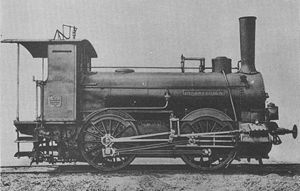Oldenburg G 1
| Oldenburg G 1 | |
|---|---|
|
"Landwuehrden" locomotive of the G 1 series
|
|
| Numbering: | 46 |
| Manufacturer: | Krauss et al. a. |
| Year of construction (s): | 1867-1877 |
| Retirement: | 1925 |
| Type : | B n2 or B n2t |
| Genre : | Freight locomotive |
| Service mass: | 21.3 t |
| Friction mass: | 21.3 t |
| Top speed: | 45 km / h |
| Driving wheel diameter: | 1,500 mm |
| Cylinder diameter: | 355 mm |
| Piston stroke: | 560 mm |
| Boiler overpressure: | 10 bar |
| Grate area: | 0.95 m² |
| Evaporation heating surface: | 75.0 m² |
|
|
This article was due to acute substance or form defects on the quality assurance side of the portal train entered.
Please help fix the shortcomings in this article and please join the discussion . Articles that are not significantly improved can be deleted. |
The class G1 steam locomotives of the Grand Ducal Oldenburg State Railways were intended for operation with both a tender and as a tank locomotive . The frame of the locomotives was designed as a water tank, which became known as the "Krauss System".
At the World Exhibition in Paris in 1867, the first of the locomotives, which was named "Landwuhrden" (picture in the info box), received a gold medal. This machine - it is the first locomotive ever built by Georg Krauss - is now in the traffic center of the Deutsches Museum in Munich, after it was bought back by Krauss in 1900 after a mileage of 860,000 kilometers and donated to the museum after restoration.
19 units were to be taken over from the Reichsbahn as class 51.70, but this did not happen because all locomotives had already been taken out of service by the time the final re-labeling plan was drawn up in 1925.
literature
- Bernhard Schmeiser: Krauss-Lokomotiven , Verlag Slezak, Vienna, 1977, ISBN 3-900134-36-7


